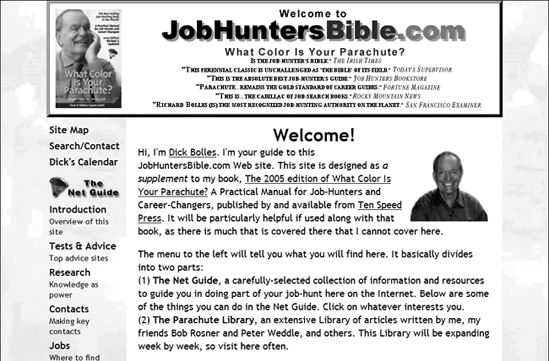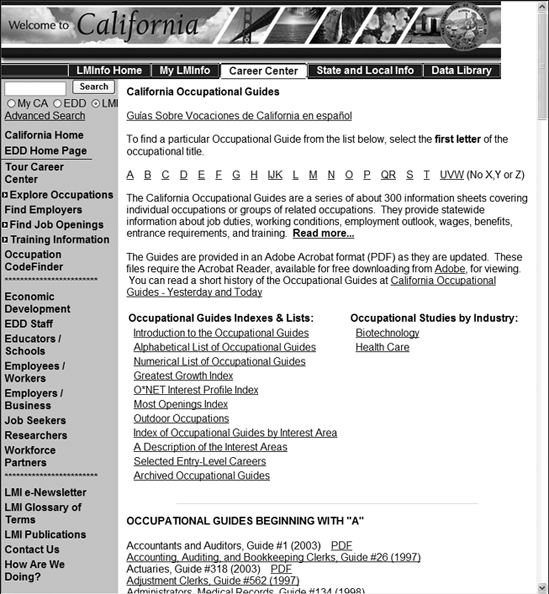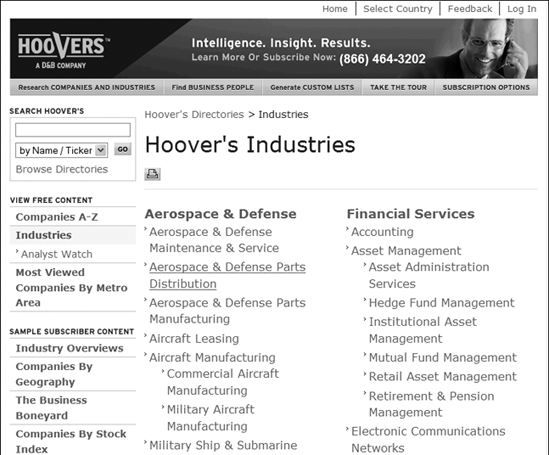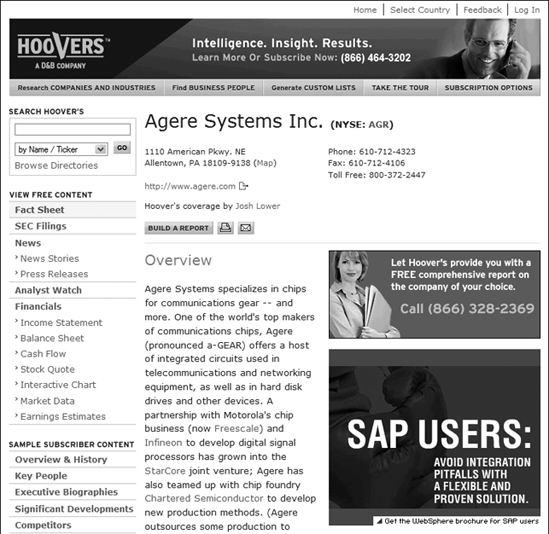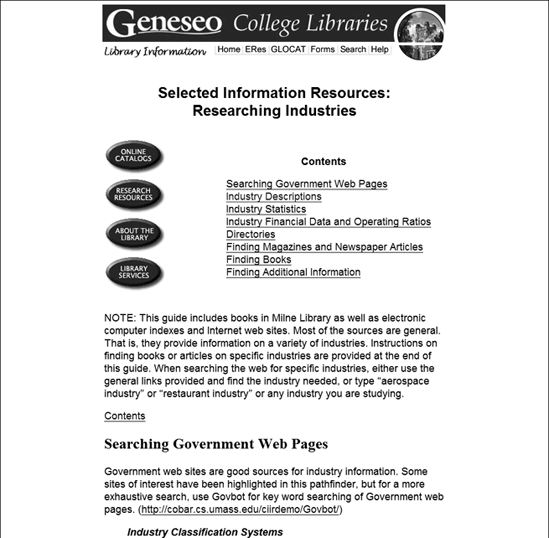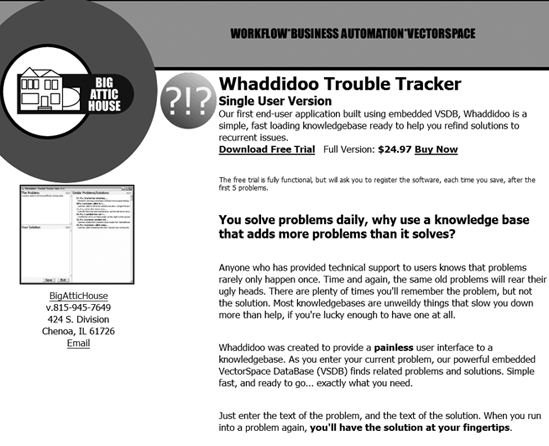CHAPTER 1
Having a Vision
We are told that talent creates its opportunities. But it sometimes seems that intense desire creates not only its own opportunities, but its own talents.
—Eric Hoffer, author and philosopher1
This chapter introduces what this book is all about: building a successful micro-ISV. But before getting into all the plans and practices of creating an Internet-based, self-funded, start-up company to sell software, a service, or a product (and make a nice pile of change in the process), I'll discuss a few issues. For example, is it really possible you can—from scratch—build a real, live company in today's global, interconnected, multinational marketplace? And if you can in theory do that, how do you in practice decide on and define an application, a Web service, or a product for which people will pay good money?
The short answer to both questions is the Internet. Ten years ago, when Netscape blew away the collective wisdom of the financial establishment, people wondered, "Where is this Internet thing going?" Now, after a dot-com boom and a bust, as well as tens of thousands of new companies—large and small—selling applications, services, and products not possible ten years ago, you can see where at least some of this is heading:
- The Internet makes possible a different kind of business model than what has worked in the past.
- The Internet means even a one-person company can connect to the right people in a billion-person market instantaneously if that person has something of value to offer.
I could bore you to death right now by citing all the little one-person start-ups that are now 60-person businesses valued in the millions or by citing all the cool apps and products popping up all over the Net being produced by other little companies, but I won't. Well, I'll mention just one: Niklas Zennström and Janus Friis started a company called Skype in Europe late in 2003. It was their fourth start-up, so they had some experience and access to capital and had weathered some legal troubles, but the bottom line was that these two guys built and sold an Internet-based company that delivered a new service to 54 million people in 24 months for $4.1 billion to eBay.
That's $4.1 billion—with a b. In 24 months.
__________
Still doubt that conventional business wisdom isn't worth the paper it's not written on? Look at your Start menu or your favorite Web sites. Besides Microsoft (or Apple) products, how many of the apps or Web services you use are sold by obviously big companies, and how many are brought to you by inconspicuously small start-ups?
Game, set, and match.
In this chapter, I'll cover four topics: how we got here, what here looks like, how you can join the micro-ISV party, and what the cover charge is for getting in the door.
How We Got Here
To understand just how you can make a bigger pile of money than you'd make in a hundred years of working in a corporation's cubicle, you'll have to jump in your handy time machine and go back in history—back before the Internet was public, back before Microsoft had more money than Norway, back when Osborne was a type of computer, back when laptops were bigger than suitcases, and back when coffee came in two flavors: Folgers and Maxwell House.
Let's say your time machine deposited you in San Francisco, California, in 1983. Ignoring the boring politics, economics, and all the rest, what was going on with software and personal computers?
- IBM had made the idea of Personal Computers (PCs) safe for businesses with its IBM PC two years before. PCs were springing up in offices all over the place.
- Hundreds of programs were available for PCs—either running CP/M or the newfangled MS-DOS operating system. But they weren't cheap; you had to buy them to try them, and most were saddled with copy protection schemes heavier than a 20-pound bicycle lock.
- Three programmers—one an IBMer in Bellevue, Washington; one an attorney and computer magazine editor based near San Francisco; and one a programmer who was one of the first programmers to leave Microsoft—each decided to buck this trend of expensive, shrink-wrapped software with a different approach. Jim Knopf (known as Jim Button), Andrew Fluegelman, and Bob Wallace were selling, respectively, a flat-file database, a modem application, and a word processor by giving the software away and requesting a small payment. All three programs, despite distributions limited to fledgling computer clubs, disk duplicators, and word of mouth, did extremely well financially. "I could not have predicted what would happen next," says Jim, in a piece he posted years later on the Internet.2
My wife said I was "a foolish old man" if I thought even one person would voluntarily send me money for the program. I was more optimistic. I suspected that enough voluntary payments would come to help pay for expansions to my personal computer hobby—perhaps several hundred dollars. Maybe even a thousand dollars (in my wildest dreams!). But my tiny post office box was too small to receive the responses from a wildly enthusiastic public.
I had always said I would never consider leaving my secure job with IBM until I was receiving at least twice as much money from another source. I was wrong. By the summer of 1984 I was making ten times as much with my little software business.
__________
In another interview,3 Jim reiterates the point:
Question: Do you believe being a shareware programmer will make you rich someday?
Answer: Well, it already has. My shareware program PC-File netted many millions of dollars in sales. If I had spent the money more wisely in my business, I would be a gazillionaire today. But as it is, I'm merely comfortably retired.
If you put your time machine in fast-forward mode, you'd see throughout the 1980s the rise and fall of shareware-centric little companies all over the world, filling specific niches in business in the United States and other countries. You'd see little tiny ads in the back of computer magazines and hear the squeal of modems dialing into Bulletin Board Systems (BBSs) at the blazing speed of 9,600 baud.
As you move into the 1990s, click Pause on your time machine in 1994. Marc Andreessen (whose University of Illinois–Champaign's undergraduate project had, through his strong tech support efforts, gotten a lot of attention) hooked up with one of the Silicon Valley start-up legends, Jim Clark. They started a company, and after a quick name change pressed on them by Andreessen's alma mater, Netscape Communications started giving away the first commercial Internet browser, as shown in Figure 1-1.
Over the next five years, Netscape went from the third largest initial public offering ever on the NASDAQ stock exchange to Microsoft roadkill. While the "browser wars" and "search engine wars" were being fought on the Internet, the number of people and businesses using the Internet continued to grow like some sort of mad scientist's dream project. Meanwhile, venture capital-funded start-ups intent on becoming first movers of something were having nightly bonfires of greenbacks in the City by the Bay, and Internet Millionaires were roaming Ferrari dealerships looking for new toys to buy. The dot-com boom was in full swing.
As you get to 2000–2001, you can speed up the ol' time machine and zip past the dot-com bust when the Other People's Money (OPM) ran out. It wasn't pretty. The mainstream media declared the Internet age officially dead, and September 11, 2001 changed everything in the real world.
While the dot-com party was coming to a screeching halt, another movement was gathering strength. It was a movement programmers in developed nations found deeply troubling: the jobs started going to India. Seemingly overnight, the party was over for programmers in the United States, the United Kingdom, Europe, and Australia, and the good times were rolling in Bangalore, Beijing, Romania, and elsewhere.
Note Since our hypothetical time machine doesn't cover side trips, I'll reluctantly skip over outsourcing and its tangible goods' twin, offshoring—not because they aren't important (they are) and not because I don't have strong feelings about them (I do) but because three other writers4 have already done a better job than I could, and this trip down memory lane is for your benefit, not mine.
___________
4. Offshoring IT: The Good, The Bad, and The Ugly by Bill Blunden (Apress, 2004); The World Is Flat: A Brief History of the Twenty-first Century by Thomas L. Friedman (Farrar, Straus, and Giroux, 2005); and Exporting America: Why Corporate Greed Is Shipping American Jobs Overseas by Lou Dobbs (Warner Business Books, 2004)
Figure 1-1. Netscape's home page in 1994
If your time machine had a micro-ISV meter, you'd be wondering if it's broken right now. As venture capital–funded start-ups were popping like balloons, little one- and two-person software companies were springing up all over the Internet, at an increasing rate. It's almost as if as the Internet grew, the shareware companies that started with Jim and Andrew and Bob in 1983 and continued through the 1980s and 1990s were starting to draw all seven lucky numbers in the evolutionary lottery. This could be interesting!
Well, the time machine has stopped, and you're now back to where you started, the here and now. What does here look like, though?
What Here Looks Like
Here looks very different from 1983. While the first Internet age died when the dot-com boom went bust, someone forgot to tell the Internet. Each year more people with faster connections are spending more time and buying more products via the Internet while interacting with more people in more ways.
First, something like one billion people now use the Internet,5 with more people all over the world getting online. One billion is such a nice round number; the cynic in you might distrust it. That's fine—it may only be 995 million, or perhaps by the time you read this it's 1.1 billion. Either way, it's the largest number of potential customers for anything—ever.
Second, e-commerce continues to grow, even faster than the number of Internet users. In the United States in 2004, online sales were estimated at $69 billion+, with predictions for 2005 heading north of $80 billion.6
Third, although no one has a handle on the hard numbers, something is changing:
- In CorpTech's (
http://www.corptech.com/) database of 95,111 high-tech companies, 20,823 have fewer than 10 employees, 12,575 have 5 or fewer employees, and 3,846 have just 1 employee. And traditionally, such databases underreport these numbers. - CNET Download.com "serves over 27,000 publishers representing 35,000 products and 132 countries around the world, [with more than] 2.3 million downloads each day." Somewhere around 85 percent of these publishers are in fact micro-ISVs.
- Several leading companies in their market segments are actually micro-ISVs: Fog Creek Software (FogBugz), Webroot Software (Spy Sweeper), and Sunbelt Software (CounterSpy) come to mind.
Although the number of small, self-funded companies is growing like wild, how they describe themselves and how they see themselves vary. Some call themselves shareware companies, others call themselves ISVs, and most don't know what to call themselves. And then along comes Eric Sink.
__________
6. http://answers.google.com/answers/threadview?id=555501 and http://www.census.gov/mrts/www/data/html/05Q1.html
Eric's article gave this new type of business a name: micro-ISV. A micro-ISV is the following:
Self-funded: This means maybe you max your credit cards and maybe Uncle Jim helps you out, but your business is going to be largely self-funded and way below the radar of venture capitalists looking for the next billion-dollar hit.
Small: This means your company is one person the majority of the time or has maybe a couple of partners. If it's larger than that, other dynamics such as what you're using for salaries come into play.
Internet: Although Eric was talking about small, independent software vendors, independent software vendors was a term coined at Microsoft to cover everyone else in the software industry it had not acquired, partnered with, or driven out of business.7 In actuality, the I in micro-ISV really means Internet, since it's the Internet that makes micro-ISVs possible, not Microsoft.
I'll have a lot more to say about micro-ISVs, a whole book in fact, but the last point I want to make before getting to the part of this chapter you really want to read (how to start your micro-ISV) is that a few years ago, we hit a point of discontinuity.
Although today's micro-ISV can trace its roots back to when shareware was born more than 20 years ago, micro-ISVs are more than that. For starters, with the laudable exception of people and companies under the open source banner, self-funded start-ups don't merely hope to get paid—they do get paid, or the software stops or the account is canceled.
On the Internet, no one knows or cares how big your company is, how many people work there, or whether you're sitting in a cubicle or sitting on your redwood deck with one of your cats in your lap. The only thing they care about is whether your software, Web service, or emerging tangible product gets the job done.
The Internet, the billion people using it every day, the hundreds of billions of dollars of commerce taking place via it, and the sheer near-instantaneous speed and connectivity of all things Internet have made micro-ISVs not just a viable way to start a company but the real next killer app.
__________
7. You'll find out more about how to stop worrying and love Microsoft (or Apple or whatever firm is big in your programming world) in Chapter 6.
Joining the Party
So, you've decided to trade in your seat and oar in some corporation's galley and start your own micro-ISV. After all, you bought this book! So, where's the party with all the attractive people, great food, cool music, and adult beverages?8 In other words, where do you start?
You start with a vision.
This isn't just an idea, a concept, a marketing niche, or a business plan. You'll need a true-blue vision to sustain you when you start working longer and harder than you ever thought humanly (or inhumanly) possible. You'll need a burning bush's worth of ambition to make it. Of the nearly 200 founders of micro-ISVs I've talked to, interviewed, emailed, or read about, the single trait that comes across in each of them is a strong desire to be their own bosses and run their own lives.
Since California strongly frowns on dispensing visions without at least a medical license, you'll have to find your own. Sorry, you won't find any easy answers here.
But what I can do in the following sections of this chapter is show you three approaches for creating the vision of what your micro-ISV could be. If you've found your muse or your muse has found you, by all means skip ahead. If not, the following sections offer you some takes on getting into the right space to find your vision.
The Systematic Approach
The following sections are a "I haven't a clue what application to write to start my micro-ISV" guide for your consideration. Your experience may vary, but these sections will at least get you going.
Step 1: Find at Least Three Interesting Industries or Marketplaces
The goal here is not to find three industries where you think your micro-ISV can make money but three areas of human endeavor you find interesting. I'll get to the money part next (in the "Paying the Cover Charge" section).
If you're not sure what you find interesting, you need to do some remedial work. Read What Color Is Your Parachute? 2005: A Practical Manual for Job-Hunters and Career-Changers by Richard Nelson Bolles (Ten Speed Press, 2004), which is an excellent guide for dissecting not just how to find a job working for someone else but what sort of topics, people, and businesses you find interesting.
And like many good books, you'll find that this classic is supplemented by a Web site (http://www.jobhuntersbible.com/), as shown in Figure 1-2.
__________
8. Er…not quite. See the "Paying the Cover Charge" section.
Figure 1-2. Finding your interests
Another way to find interesting parts of the economy is to refer to the more than 300 California Occupational Guides (http://www.labormarketinfo.edd.ca.gov/cgi/career/?PageID=3&SubID=139), as shown in Figure 1-3.
Figure 1-3. Starting your career goals with A
Of course, you can always research industries by…researching industries. Visit the excellent research portal hosted by market research firm Polson Enterprises at http://www.virtualpet.com/industry/howto/search.htm#identify, as shown in Figure 1-4. Don't let the dull appearance and lack of pretty pictures fool you; you can spend the next year or so just working through half of the Web sites listed at this site.
Figure 1-4. Researching industries step by step
OK, so you want pictures. Check out Hoovers, one of the early Internet-based business research companies that's now a Dun & Bradstreet company. The breakdown of industries at http://www.hoovers.com/free/ind/dir.xhtml, as shown in Figure 1-5, leads to a helpful list of major players, which in turn leads to a free dossier about each company, as shown in Figure 1-6.
Figure 1-5. Exploring Hoovers
Figure 1-6. Viewing a company snapshot at Hoovers
Prefer a more academic approach? The State University of New York at Geneseo has a good list at http://library.geneseo.edu/info/sirind.shtml, as shown in Figure 1-7.
Now, the tough part of step 1 isn't finding information, and it isn't getting your head rearranged by the plethora of information available. Don't try to do this in one sitting or be overly serious about it. You haven't made any emotional investment yet, and you can go wherever you like. Just start a new bookmarks folder in your favorite browser, stick it at the start of your bookmarks toolbar so you can actually find it again, and let your fingers do the clicking for you.
When the list is feeling long enough, you're ready for step 2.
Figure 1-7. Taking a more academic approach
Step 2: Research Computer-Related Topics in Your Three Markets
Here's a nice bit of pseudocode for you: for each interesting industry/marketplace, find three interesting segments, and research who and how people/organizations use computers and are making money.
Take, for example, agriculture: this is a big industry, with lots of needs. But am I talking about small farmers, agribusiness, food transport companies, distributors, large retail chains, or the corner neighborhood store?
Dig deeper with the tools you liked in step 1.
And as you look at your favorite segments, figure out who uses computers and who is making money and therefore has money to spend. If your potential market targets don't have money and don't use computers, it's unlikely they'll connect with and buy from your micro-ISV.
Step 3: Talk with People Working in Each Market
Pick up the phone, and call them. Ask them, "Hi, I'm [insert name here]. I'm thinking about writing a [desktop application][Web-based service] to help people who do what you do. What problems do you have you wish were solved?"
It may sound weird to call up people you've never met, and some may take offense and hang up on you. But if you make it clear you're not looking for a job or a donation, some of these people will start getting excited and start telling you about issues you never knew about the industry market segment you're interested in; before you know it, you might find a really good problem that you can solve in a totally cool way and make money for doing so!
This is called defining the problem domain. Write a one-page, top-level description about how you'd apply your technical know-how to solve the problem you just heard about and got excited about. Keep it to one page, if you can. (If you just can't, that's a good sign.)
You might be tempted to stop after the first person you connect with, but resist that temptation. You're still in the exploration stage, and the next person you talk to might have an even more interesting problem that you could solve in an even cooler way while making even more money! Do some due diligence here, and corral a set of possibilities; you'll need them for the gloomy step 4.
Step 4: Determine Whether Someone Already Solved the Same Problem in the Same Way
Your goal in this step is to winnow your list to just those possible apps on which you can build a successful micro-ISV. For each of your possible apps for a potential market segment, pretend you get a $10,000 check if you can find on Google the same solution to that problem. If you find that solution, put that choice out of its misery, and cross it off your list now. Congratulations—you just saved substantially more than $10,000!
Micro-ISVs have the advantages of being fast, nimble, and flexible, but they're roadkill when going up against an established, large company already selling the same solution. Don't go there; it will hurt.
This step does have some wiggle room: what does in the same way mean? If you have a potential app that solves a problem that existing companies solve but does it much better, or much more cheaply or much more deeply, you may still have a chance.
Having competitors is a good thing—they give you legitimacy, potential customers, price points, and all sorts of good things, if, and only if, you can do a better job of solving some or all of the problems they solve for their customers in a new way and those potential customers aren't locked in tighter than the occupants of the penitentiary at Leavenworth, Kansas.
Step 5: Listen to Yourself
By this point in this process, you've most likely found two or three market segments that have computers and money to spend with problems you can solve that aren't currently being solved. Now it's decision time: which one do you pick?
Put another way, you're about to trade a couple of years of your life and more hard work than you ever imagined for the chance to maybe, just maybe, make some serious money while living and breathing the challenges, concerns, and worldview of your selected market segment. Are you really comfortable with that idea? Do you like these people and feel good when their lives improve? If not, move to the next item on your list. If so, welcome to your new life.
The Joel Approach
So, perhaps a smarter way exists for finding the right application to build. Joel Spolsky, founder of Fog Creek Software and a "graduated" micro-ISV, has a different approach.
An Even Shorter Approach
"What's your `dammit'?" says Mike Johnson, chief executive officer (CEO) of BigAtticHouse Software (http://www.bigattichouse.com/whaddidoo.html), as shown in Figure 1-8. He add this:
When you find a customer's "dammit" (the part about their current process or software that eats up their day and makes them say "Dammit!"), then you have found something you can build. You just found a project.
Immersed in a domain/field for a year or more, and you can find "dammit" for a whole industry. You just found a product.
In case you're wondering about the history, it's just that I noticed when speaking with secretaries and managers that they tend to have something they must "fight with" every day on their systems…hence "dammit." I just try to help find their "dammit" and make it go away.
Whatever approach you take to finding the right problem you can solve and people are willing and able to pay you to solve, take heart. Every technological, social, and business advance; invention; or labor-saving innovation has a whole new slew of problems, hassles, and annoyances just waiting.
Damn it!
Figure 1-8. Exploring BigAtticHouse.com
Paying the Cover Charge
Before you head to the following chapters, which cover the nuts and bolts of building your micro-ISV and your first commercial application, I'll discuss a rather large charge on your account in life that this little venture is going to cost you.
Make no mistake—writing a commercial-grade application and defining and building your micro-ISV are going to take a large bite out of your life for at least months, probably years, and there's always the chance that all your blood, sweat, toil, and tears will get you exactly nothing.
All the parts of starting a micro-ISV are (except for writing the actual code) pretty simple. In other words, the tasks are simple like moving the ball down the field in soccer, or American football, or sometimes more like rugby or Australian rules (what rules?) football—and sometimes just as painful. Simple doesn't—emphatically—mean the same as painless.
If you'd like to avoid some of this pain, the following are eight opinionated rules for you to consider before taking the plunge:
Rule 1: Be prepared to work more and longer hours than you ever thought possible: If you thought working in today's Internet-speed IT world was grueling, wait until you try to both work in IT in some fashion and start your micro-ISV. Remember the self-funded part of the micro-ISV definition? This means odds are good you'll be working days, nights, weekends, and your birthday to get your micro-ISV off the ground.
Rule 2: The only thing you get for free is failure: While the direct costs of starting a micro-ISV are potentially as little as zero, using certain tools and services will significantly improve your chances of producing a successful micro-ISV. These tools will cost money, and you'll have to finance your regular monthly expenses.9 Yes, you can get away with financing your micro-ISV on credit, but you'll pay for it in stress.
Rule 3: If you have a wife, husband, spouse, significant other, or combination thereof, fully disclose what you're going to do, and get their buy-in before you start: Do this, or don't even start. Some things money can't buy, and if you lose sight of that, you'll bitterly regret it. On the plus side, having a supportive person—not to mention a steady second income coming in—can make all the difference between success and failure. For me, without Tina's support, love, and help, I wouldn't have gotten my micro-ISV off the ground, let alone written this book.
Rule 4: You'll need a plan: Actually, you'll need a bunch of them—an application development plan with milestones, a software development plan, a code backup plan so your code base doesn't disappear one fine day, a Web site development plan, a payment processing plan, a tech support plan, a marketing plan, and so on.
Now, you could spend, say, six months or so defining and detailing each part of each plan. Don't. Planning is good, and you'll need to do some, but all the plans in the world aren't going to earn you a single dollar. Also, you don't yet know what you don't know that you need to know. Plan in broad strokes, and fill in as needs and circumstances dictate, but paralysis by analysis has been the downfall of many too obsessive IT people.
Rule 5: Law 1440 doesn't take a day off: Just like gravity, you can't ignore that you get 1,440 minutes to the day and no more. If you haven't gotten good at managing your time and tasks at your day job, you need to find the time and task management procedures that work for you. You'll find more about living with Law 1440 in Chapter 4.
Rule 6: Focus on revenue: This is a simple but profound rule. How do you decide whether to add a feature to your first application? Focus on revenue. Don't know what to do next today among half a dozen different tasks? Focus on revenue. Building a micro-ISV is all about making money: other programming efforts may be noble, but a micro-ISV is all about the money, and you need to prioritize your time on what is going to maximize your revenue.
Sometimes you can overdo applying this rule; it's not just about today's revenue but also this week's and month's and year's revenue. Don't forget that your customers expect to see a better product over time, including more useful features and less obnoxious bugs.
__________
9. Good news! I can confidently predict you'll save a pile on vacations. You won't have one for the first three years.
Rule 7: Listen: Listen to your beta testers, your market, your customers, and your potential customers. You don't already know everything; otherwise, you'd be so rich you wouldn't need to build a micro-ISV. A little considered listening can go a long way to finding the tipping point from a struggling to a soaring micro-ISV.
Rule 8: Rock on: Don't spend your days in a cubicle wondering if you can turn that burning desire in your guts into something real—go for it!


